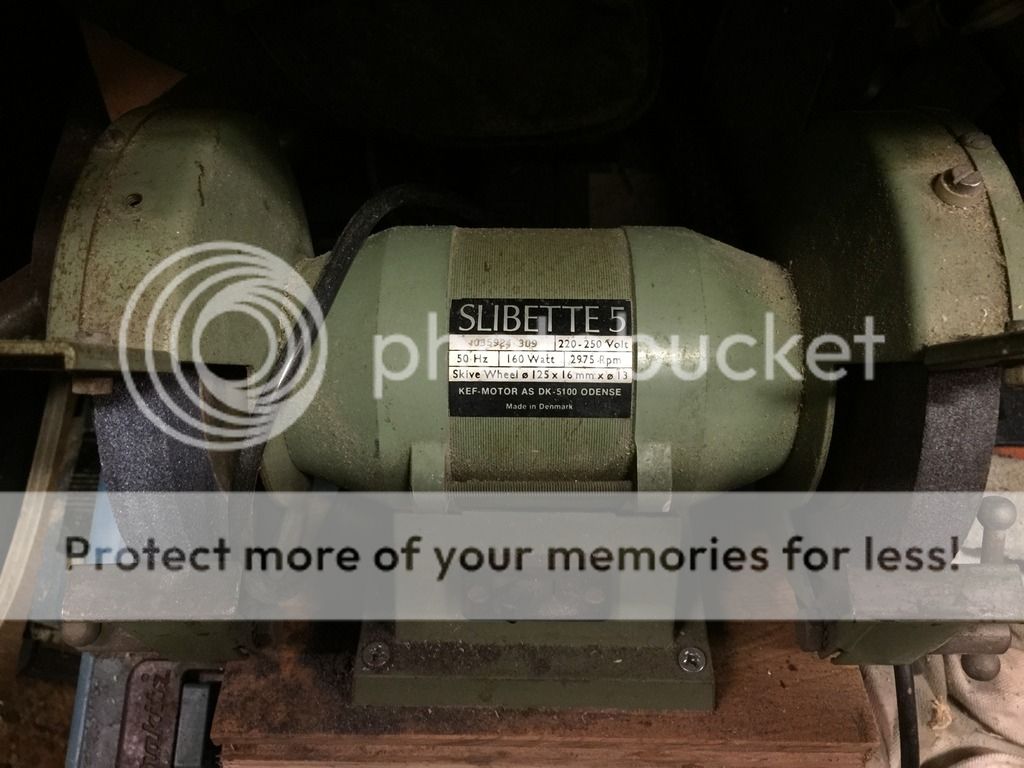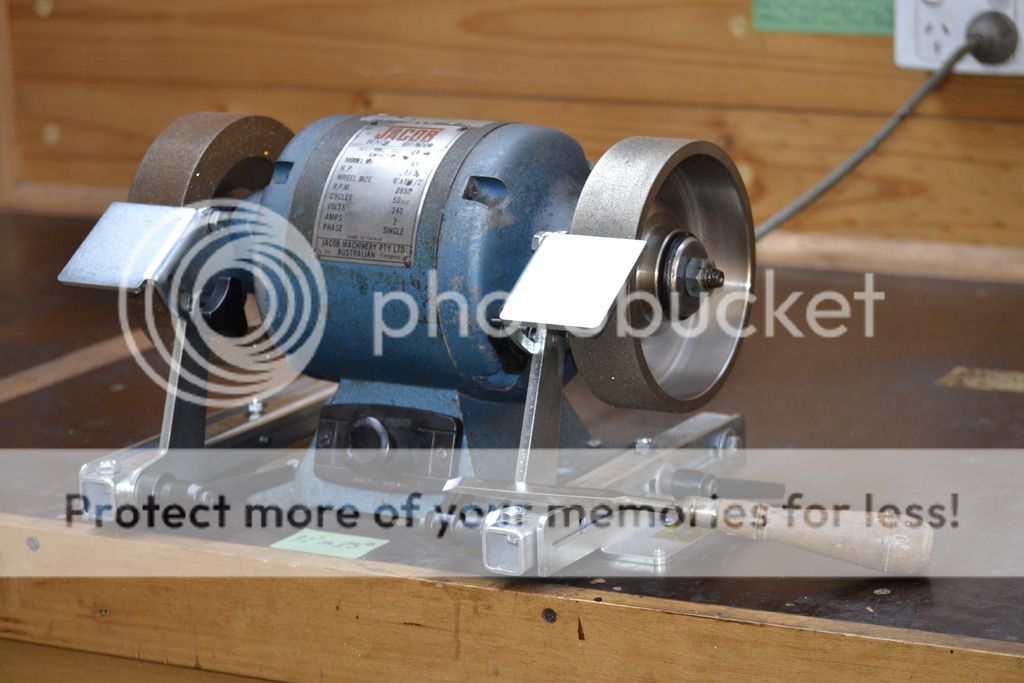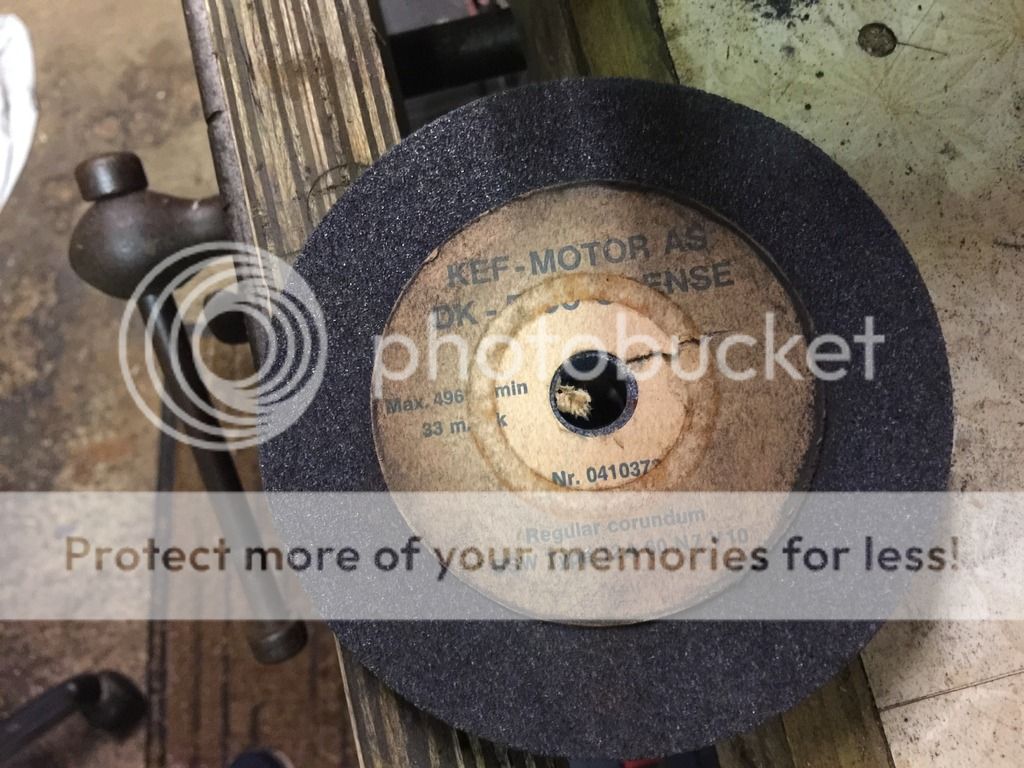I do it like Paul Sellers, though I try to minimize the camber. I also use my belt grinder but I mostly use it to reset the angle and do touch ups on the hand stone. Once I get some fine trizacts I might just do it all on the grinder.
You are using an out of date browser. It may not display this or other websites correctly.
You should upgrade or use an alternative browser.
You should upgrade or use an alternative browser.
Freehand Sharpening - which technique?
- Thread starter bugbear
- Start date

Help Support UKworkshop.co.uk:
This site may earn a commission from merchant affiliate
links, including eBay, Amazon, and others.
swagman
Established Member
The chisel shown within the bottom photo received a full 25* hollow ground on the 180 grit cbn wheel ( formed a light burr to the front edge ) with no obvious signs of residual heat being generated. Quite astonishing considering its a 6 inch grinder running at 2700rpm.
Stewie;
Stewie;
memzey
Established Member
swagman
Established Member
memzey; attached is the supplier I used. http://www.cwsonline.com.au/shop/catego ... cbn-wheels
Stewie;
Stewie;
memzey
Established Member
I think my grinder is a 5" model. Can't find anyone supplying CBN wheels for that size :duno:

£12.50 (£1.25 / count)
£14.45 (£1.44 / count)
JSP M632 FFP3moulded Disposable Dustmask (Box of 10) One Size suitable for Construction, DIY, Industrial, Sanding, dust protection 99 Percent particle filtration Conforms and Complies to EN 149
Amazon.co.uk

£17.99 (£1.80 / count)
£27.44 (£2.74 / count)
3M 8822 Disposable-fine dust mask FFP2 (10-pack)
Amazon.co.uk

£19.46 (£3.89 / count)
£19.99 (£4.00 / count)
Stealth Lite Pro FFP3 Face Masks UK Certified Dust Mask. 99.99% particle filtration, air filter reusable face mask. FFP3 Mask -7 day use per Construction, Woodworking, DIY and Welding Mask
Amazon.co.uk

£26.99 (£1.35 / count)
VEVOX® FFP2 Dust Mask - Set of 20 - Valved Face Masks - Respirator - Protection e.g. for Construction, Building Work, Sanding, Woodworking, Fine Dusts, Aersoles or Particles
SLSK Ventures GmbH (UK)
swagman
Established Member
memzey; you may be able to remove the existing guards and fit a 6 inch cbn wheel; I would recommend you purchase the wider face 40mm cbn wheels; also check the rpm rating on your grinder (up to 3000 rpm on most cbn wheels);
memzey
Established Member
I'll check tonight and post some pics if SWMBO allows me a bit of shed time!
memzey
Established Member
Ok here is a pic of my grinder:

It may be old and diddy but it's a great little machine. Superbly balanced, whisper quiet and meets my occasional needs. Made in Denmark in the 1980's or so I'd guesstimate. The only reason I'm considering a new disc for it is that I've gauged the corse grit one quite badly with some very crude reshaping of steel I did a while back.
Now there is not adequate clearance for a 6" stone but I think I can remove the covers which would mean it would fit but I'd be left without tool rests (not that they are great or anything but they are better than nothing). Would doing this mean I'd need to replace both sides in order to retain the balance of the machine?

It may be old and diddy but it's a great little machine. Superbly balanced, whisper quiet and meets my occasional needs. Made in Denmark in the 1980's or so I'd guesstimate. The only reason I'm considering a new disc for it is that I've gauged the corse grit one quite badly with some very crude reshaping of steel I did a while back.
Now there is not adequate clearance for a 6" stone but I think I can remove the covers which would mean it would fit but I'd be left without tool rests (not that they are great or anything but they are better than nothing). Would doing this mean I'd need to replace both sides in order to retain the balance of the machine?
swagman
Established Member
memzey; the cbn wheels are machine balanced at the factory so I see a concern with running the 1 cbn wheel; I note from your attached photo your grinder is rated at 2975rpm; I have forwarded a question to another forum site to find out what the impact will be on the rpms fitting to a larger 6 inch dia. wheel; an important question considering the cbn wheels are rated up to 3000rpm. (These wheels can be mounted on a 3000 RPM or 1500 RPM bench grinder.) http://www.cwsonline.com.au/shop/item/v ... -cbn-wheel
Another check you will need to do is measure the shaft dia. on your grinder. Within your photo it states the grinding wheel internal dia. at 13mm; the smallest bushes supplied with the Vicmarc cbn wheels are in imperial at 1/2 inch (12.7mm). The bushes need to be a slide fit only on the shafts to maintain perfect balance when running.
Stewie;
received a reply on the question I sent out;[/b] There is no change in RPM but the velocity of the surface of a 6 inch wheel is higher than for a 5 inch wheel. The ratio of the diameters will tell you how much faster (6/5 = 1.2) 20% higher surface speed for 6 inch wheel as compared to 5 inch wheel.
\
Note - it may take a bit longer for the 6 inch wheel to spin up to rpm if it is heavier or if the weight is distributed non uniformly to the outside of the new wheel.
Another check you will need to do is measure the shaft dia. on your grinder. Within your photo it states the grinding wheel internal dia. at 13mm; the smallest bushes supplied with the Vicmarc cbn wheels are in imperial at 1/2 inch (12.7mm). The bushes need to be a slide fit only on the shafts to maintain perfect balance when running.
Stewie;
received a reply on the question I sent out;[/b] There is no change in RPM but the velocity of the surface of a 6 inch wheel is higher than for a 5 inch wheel. The ratio of the diameters will tell you how much faster (6/5 = 1.2) 20% higher surface speed for 6 inch wheel as compared to 5 inch wheel.
\
Note - it may take a bit longer for the 6 inch wheel to spin up to rpm if it is heavier or if the weight is distributed non uniformly to the outside of the new wheel.
swagman
Established Member
memzey; attached details fitting cbn wheels to your grinder; the Vicmarc cbn wheels do come supplied with a flanged bush and outer washer; refer to the photo;s I posted to better understand which side of the cbn wheels should face the outside.
Stewie;
skip to the 2min mark on this youtube video.
https://www.youtube.com/watch?v=RgV9lVxojh4

Stewie;
skip to the 2min mark on this youtube video.
https://www.youtube.com/watch?v=RgV9lVxojh4

lurker
Le dullard de la commune
Memzey for lots of reasons, not least safety I'd advise you not to fit a larger wheel than the machine is designed to hold.
Talk to me at Richard Arnolds on Saturday about it.
If possible bring the grinder.
The damaged wheel ........cant you just dress it?
Talk to me at Richard Arnolds on Saturday about it.
If possible bring the grinder.
The damaged wheel ........cant you just dress it?
lurker
Le dullard de la commune
swagman":2qu041xd said:memzey; you may be able to remove the existing guards and fit a 6 inch cbn wheel; I would recommend you purchase the wider face 40mm cbn wheels; also check the rpm rating on your grinder (up to 3000 rpm on most cbn wheels);
Sorry! but this is dangerous advice.
lurker
Le dullard de la commune
DennisCA":1afphxh8 said:Build new guards...
Its not just a question of guards
Phil Pascoe
Established Member
I believe not, as the CBN wheels don't fracture or throw masses of hot sparks.lurker":2sulis1a said:swagman":2sulis1a said:memzey; you may be able to remove the existing guards and fit a 6 inch cbn wheel; I would recommend you purchase the wider face 40mm cbn wheels; also check the rpm rating on your grinder (up to 3000 rpm on most cbn wheels);
Sorry! but this is dangerous advice.
lurker":2cqumqv4 said:DennisCA":2cqumqv4 said:Build new guards...
Its not just a question of guards
Then what is it?
memzey
Established Member
Cheers guys. I'll bring it to Richards do on Saturday with a few other oddities for show. I don't use it that much but would like to get it sorted if possible as when I do need it nothing else will really do.
Back on to the topic of this thread; the reason I don't use it that much is because I freehand on oil stones for all my sharpening. My technique; wang it up and down a lily white Washita, in an impatient fashion and at a rough approximation of 30* for about 10 seconds or until an even burr is formed. Then repeat for about another 10 seconds or so on a black Arkansas (at a minutely higher angle if I remember to) then strop. I generally end up with a slightly convex bevel but that's not on purpose just a byproduct of doing it this way. The whole process means the plane iron if off the stock for less than 2 minutes. All my edge tools dry shave hair easily. I should also say that I am the infamous beginner many people refer to with respect to using jigs etc to make sharpening easier. Terrified me at first but last year I took the plunge with a couple of old stones I picked up at boot fairs for 50p a pop and after about half an hour or so I was getting perfectly acceptable results using a fine India stone. I did succumb to jiggery once when I purchased a Kell jig off the bay for a decent price (or so I thought). Beautifully engineered if that is what interests you. Profoundly useless if making edge tool sharpening a quick and easy process is what interests you. This is all, of course, just my honest opinion based on personal experience. Others may differ and that is fine by me .
.
Back on to the topic of this thread; the reason I don't use it that much is because I freehand on oil stones for all my sharpening. My technique; wang it up and down a lily white Washita, in an impatient fashion and at a rough approximation of 30* for about 10 seconds or until an even burr is formed. Then repeat for about another 10 seconds or so on a black Arkansas (at a minutely higher angle if I remember to) then strop. I generally end up with a slightly convex bevel but that's not on purpose just a byproduct of doing it this way. The whole process means the plane iron if off the stock for less than 2 minutes. All my edge tools dry shave hair easily. I should also say that I am the infamous beginner many people refer to with respect to using jigs etc to make sharpening easier. Terrified me at first but last year I took the plunge with a couple of old stones I picked up at boot fairs for 50p a pop and after about half an hour or so I was getting perfectly acceptable results using a fine India stone. I did succumb to jiggery once when I purchased a Kell jig off the bay for a decent price (or so I thought). Beautifully engineered if that is what interests you. Profoundly useless if making edge tool sharpening a quick and easy process is what interests you. This is all, of course, just my honest opinion based on personal experience. Others may differ and that is fine by me
swagman
Established Member
phil.p":1shbbnmt said:I believe not, as the CBN wheels don't fracture or throw masses of hot sparks.lurker":1shbbnmt said:swagman":1shbbnmt said:memzey; you may be able to remove the existing guards and fit a 6 inch cbn wheel; I would recommend you purchase the wider face 40mm cbn wheels; also check the rpm rating on your grinder (up to 3000 rpm on most cbn wheels);
Sorry! but this is dangerous advice.
phil.p; thank you for raising that valid point; I would not have suggested removing the grinding wheel guards had the new grinding wheels been made from silicon carbide, chromium oxide, or aluminium oxide. Eye protection should always be worn when operating a grinder, especially when grinding metal.
Stewie;
There is another advantage in that there is never any risk of these wheels exploding. They will not chip or crack from tool dig ins. You can not crack them from over tightening the nut. If you drop them they will not break. http://www.robohippy.net/featured-article/
I wonder what the 3k limit is on the wheels. I've been running a 6" full speed grinder (3600) with no ill effects, and I believe my wheel is steel (I thought it was aluminum, but the seller says they're steel - which would explain the weight).
The seller who sold mine also says 3600 is fine.
Perhaps it's a thing related to 60hz electricity vs. 50? Don't know.
I do like to have the guard on my grinder as I don't always wear glasses and the guards are substantial on my grinder such that you can stand inside the arc covered by the guards and get nothing off of the cbn wheel. The bits that the wheel shaves off are substantial and if you stand outside of the radius the guard covers, you can feel them and you would absolutely want to wear safety glasses. I would want to avoid getting hit by the little stingers no matter what (the wheel is 80 grit).
(my guards are the cast baldor type, they cover most of the wheel, but the end cover doesn't fit on with them, so it is off and a bit of the wheel is exposed).
The seller who sold mine also says 3600 is fine.
Perhaps it's a thing related to 60hz electricity vs. 50? Don't know.
I do like to have the guard on my grinder as I don't always wear glasses and the guards are substantial on my grinder such that you can stand inside the arc covered by the guards and get nothing off of the cbn wheel. The bits that the wheel shaves off are substantial and if you stand outside of the radius the guard covers, you can feel them and you would absolutely want to wear safety glasses. I would want to avoid getting hit by the little stingers no matter what (the wheel is 80 grit).
(my guards are the cast baldor type, they cover most of the wheel, but the end cover doesn't fit on with them, so it is off and a bit of the wheel is exposed).
Similar threads
- Replies
- 39
- Views
- 2K
- Replies
- 13
- Views
- 3K
- Replies
- 13
- Views
- 882




























